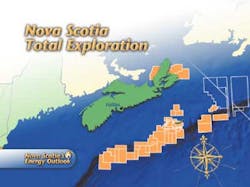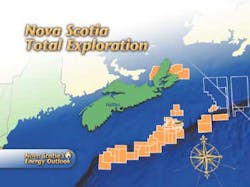OFFSHORE CANADA: Nova Scotia planning new energy policy, enlarging energy frontier
New exploration efforts, including seismic data acquisition and drilling activity, are part of Nova Scotia's plan to build a significant natural gas province in the Northwest Atlantic Ocean. Early this year, PanCanadian announced a significant gas discovery under the Panuke oil field, of particular interest because it confirms the presence of natural gas in another geological strata besides the Sable Island producing zone. And in June, the company announced the signing of agreements to transport up to 400 MMcf/d of natural gas from Deep Panuke to markets in Atlantic Canada and New England.
With the opening of the Sable Offshore Energy Project (SOEP), Nova Scotia saw the development of a new pipeline system to deliver gas to energy markets in Nova Scotia, New Brunswick, and New England. Canadian customers received gas in November 2000.
There is mounting interest in the deepwater potential off the Scotian Shelf, and more companies are prospecting. Kerr-McGee and BP got into the act in the last bidding round. Total investment on the 50 areas now licensed is nearly $680 million. With this many license areas in the mix, the likelihood of another find is great. And with that likelihood comes a need for an energy policy that will encourage foreign investors.
Petroleum policy
Nova Scotia Premier John Hamm headed a forum that met in Halifax, Nova Scotia, in mid-June to begin laying the groundwork for an energy plan. He said that Nova Scotia is "looking outward to new markets and opportunities." Paul Cellucci, US ambassador to Canada, a former governor of Massachusetts, and a keynote presenter, said the US has a vested interest in the success of the new energy business in Atlantic Canada.
The meeting was titled "Open to the World." The objective of the forum was to create a vision for the energy industry development that will bring about a world-class energy sector, optimize the financial standing of the province, and preserve and protect the environment.
Nova Scotia has a fair sector of renewable power suppliers, a large fishing industry, and strong environmental concerns. The broad list of attendees included representatives from such operators as Marathon, Kerr-McGee, PanCan-adian, and ExxonMobil Canada. Also included were pipeline companies, service companies, renewable energy companies, the business community, fisheries, environmental groups, academicians, and electricity, coal, and oil companies. The Honorable Peter Lougheed, Premier of Alberta from 1971 to 1985 when the province saw unprecedented oil and gas industry development, and Sir Graham Day, Chairman of Hydro One Inc., co-chaired the forum.
Other forum issues
Some of the issues presented in the June forum ranged from relatively long-term to very immediate:
- Measurable strategy: Criticism focused on the 1991 official energy strategy, which was faulted for not being quantifiable, measurable, or "followable."
- Regulatory terms: Royalty and regulatory concerns also were aired, with emphasis on delineating responsibilities and requirements to create a certainty that business and legal process will facilitate investment.
- Long cycle time: David Golder, Marathon Oil's Senior Vice President for Commercialization & Development, pointed out the need for long-range planning, noting that the cycle time for exploration and development is 5-7 years. He encouraged policy makers to evaluate the full range of probable outcomes to prepare for possible development scenarios and to avoid radical shifts that could deter investors when the time comes for project development.
- Industry expertise: There were strong advocates for engaging consultants with industry experience - instead of relying solely on the provincial and federal government - in order to best capitalize on developing these resources.
- Training and recruitment: Nova Scotians want jobs, but there are critical training and recruitment issues. With the dearth of qualified personnel across the entire oil and gas industry, this issue, which will affect the entire industry for many years to come, is doubly important for a developing area where the pool of experienced people is very small.
- Headquarters location: Many participants want Nova Scotia to act as a headquarters for new projects instead of as an outpost. Native Nova Scotians don't want to be overrun by foreign investors, and in the view of many, should not assume that foreign dominance is a foregone conclusion. The prov-ince's location near the coast of a buoyant North American market is a big selling point, according to Peter O'Brien, Vice President Atlantic Canada, Canadian Federation of Independent Businesses, and should be capitalized on accordingly.
Immediate needs
There was no question of the forum's immediacy. Development in the province is underway, and significant issues are already on the horizon. Government and industry will have to work together to create a road map for investment in order to make the most of the positive investment climate. The creation of an energy policy is the first step in the process.
Attendees at the forum were advised that Nova Scotia represents one of a number of choices for international investors and that if the province is not prepared to welcome foreign companies, those companies will find other places to prospect for oil and gas.
Historically, Nova Scotia has relied upon coal as an energy source. Coal usage will likely remain level in the future, but planned mine closures will necessitate the increased importation of coal. As the face of this established industry changes, the door is opening to other energy sources.
With a history of financial difficulties, Nova Scotia wants to see quantifiable benefits from the gas and oil potential that lies offshore. The expectation is that with the hoped-for influx of investors, the province could soon be out of the red.

